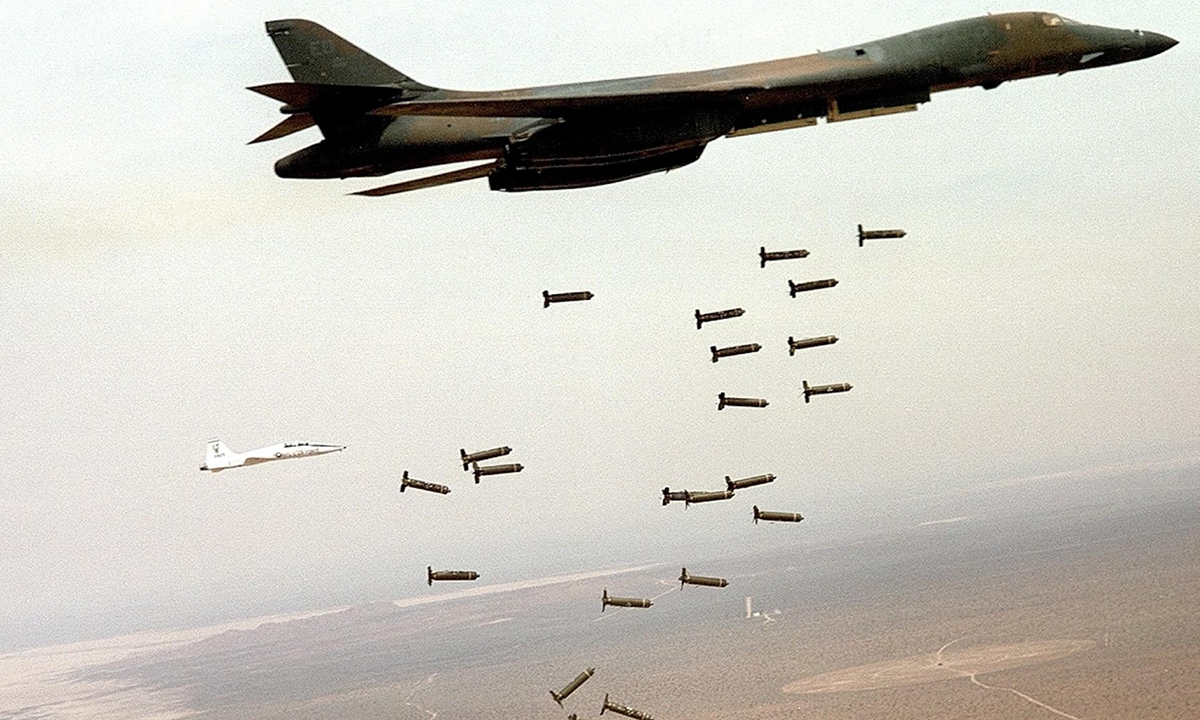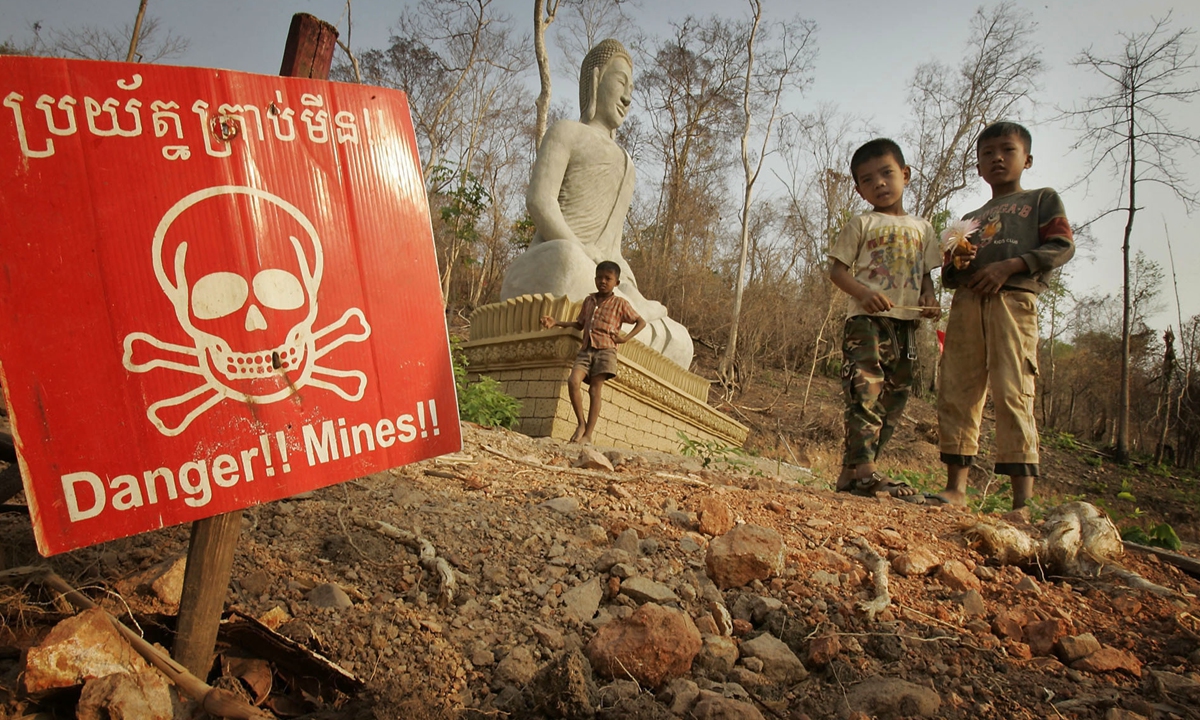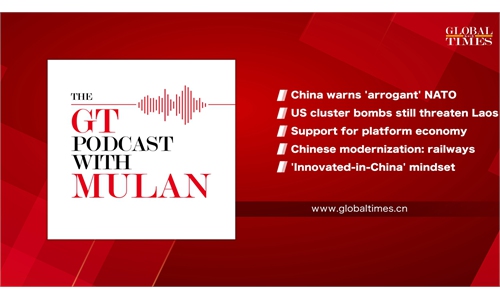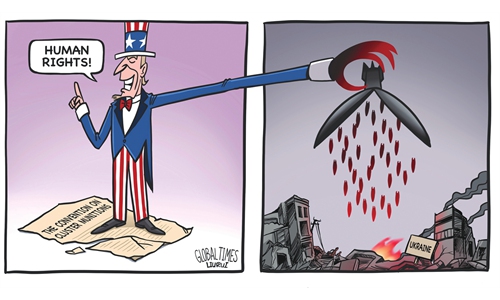IN-DEPTH / IN-DEPTH
US cluster bombs continue to plague Laos, Vietnam and Cambodia
Deadly American gifts

A B-1B Lancer drops cluster bombs during a live fire exercise in 2020. Photo: AFP
Editor's Note:Recently, the US' Department of Defense (DOD) announced an $800 million military aid package to Ukraine, which will include cluster munitions, sparking widespread condemnation from the international community. Cluster munitions are a type of explosive ordnance that can be launched from airplanes, missiles, or cannons, and can contain hundreds of submunitions, which are dispersed over a large area aerially, causing casualties and damage in a wider area. What's even more alarming is that if these bombs land on wet and soft ground, a significant portion of them can become "duds." The "duds" did not explode initially, but will explode later when subjected to external forces or environmental changes.
The US has used cluster bombs multiple times in wars. During the Vietnam War, Vietnam, Laos, and Cambodia were heavily targeted with cluster bombs. Several decades later, the specter of cluster bombs still looms over these three countries. Civilians face unknown dangers, and economic development is constrained. What is even more terrifying is that the local populations have and might continue to be stuck in this state of uncertainty and perpetual danger for decades.

Children play near a landmine warning and a Buddhist shrine in Cambodia in March, 2005. Photo: VCG
Ho Van Lai, 26, lost both his legs and right arm when he was only 10 years old due to cluster munitions. One day in June 2000, while playing with his two cousins near his home in Quang Tri Province in Vietnam, his cousins found what appeared to be a tennis-ball-sized "toy," but it turned out to be a cluster bomb. The bomb exploded after it was touched, killing his cousin and seriously injuring Ho, according to Project Renew, an NGO in Vietnam. Ho's family home was next to a US military base occupied by American soldiers and where weapons were stored from 1966 to 1972.Ho's horrific is just an example of the fate shared by a large number of people who continue to suffer through the nightmare of undetonated cluster bombs. Public reports showed that the cluster bombs in Vietnam, Laos, and Cambodia were mostly left behind by the US military during the Vietnam War.
According to the Lao National Regulatory Authority for Unexploded Ordnance (UXO), between 1964 and 1973, over 270 million cluster munitions were dropped by US warplanes in Laos, with approximately one-third of them failing to detonate.
These bombs have posed a significant safety hazard to the local population since the end of the war. Some 80 percent of the people in Laos rely on agriculture, but it is too dangerous for them to farm, Reuters reported.
Laos, which neighbors Vietnam, was not directly involved in the Vietnam War. However, it was subjected to intense bombing by the US military. Analysts noted that on the one hand, it was because Vietnam's territory is long and narrow, and the central region, which saw heavy fighting, lacked strategic depth. As a result, some combatants would seek refuge in neighboring Laos. Moreover, North Vietnamese forces would utilize Laos' dense jungles to transport weapons and ammunition, creating a hidden supply line known as the "Ho Chi Minh Trail" along the Laos-Vietnam border.
Between 1964 and 1973, the US dropped over 2 million tons of bombs on Laos, a number roughly equivalent to the country's population at the time. This staggering quantity of bombs dropped on Laos during the Vietnam War surpassed the combined total dropped on Germany and Japan during World War II. Consequently, Laos holds the unfortunate distinction of being the most heavily bombed country per capita in history. The covert nature of this conflict was intentional, as the CIA sought to disrupt communist supply routes between Laos and Vietnam, read a CNN report.
The bombing campaign was conducted in secrecy, only coming to light through a congressional hearing in 1971 and subsequent media reports. However, the true extent of the devastation caused by this "secret war" in Laos remains largely unknown to the American public, read the report.
From 1965 to 1973, the US dropped some 230,516 bombs on 113,716 sites in Cambodia, according to Yale University. Analysts pointed out that many of the bombs did not explode and are scattered in the border areas of Cambodia, causing great harm to the local environment and development. Local media reported that the affected area in the country due to cluster bombs is about 700 square kilometers.
For decades, farmers in Vietnam, Laos, and Cambodia have suffered frequent accidentally triggered explosions while working on the land. Construction teams also unintentionally detonated bombs left in the ground while building foundations or repairing roads. Moreover, many children mistook bombs for toys and touched them out of curiosity, resulting in casualties and fatalities. Tragedies related to cluster bombs continue to occur in these three countries.
Farming on the battlefield
Analysts noted that in Laos, Vietnam, and Cambodia, all predominantly agrarian, are the countries that were most affected by the legacy of American bombs.
On one hand, the constantly looming threat of detonating bombs poses a huge safety hazard. Farming is like going to war, and farmers live under constant fear of accidental detonations. On the other hand, the bombs contain highly dangerous and polluting chemicals, causing severe contamination of the local soil and water. This environmental damage is difficult to address in the short term. The dilemma faced by these areas is that clearing unexploded bombs requires a significant amount of manpower and resources, which comes at a huge cost. The prerequisite for this is economic development, which in turn relies on a stable environment. This creates a "deadlock" and is an important reason for the persistent poverty in these countries decades after the war.
During the Vietnam War, many cities in Vietnam also suffered from heavy bombing. To this day, these cities are still plagued with cluster bomb contamination, which has had a serious impact on people's lives and economic development.
Public reports in 2018 revealed that Vietnam has 61,000 square kilometers of bomb-contaminated land, accounting for nearly 20 percent of the total land area. In addition, the water bodies and soil of the Mekong Delta and Red River Delta have also been affected by pollution, which has had a huge impact on Vietnam's economic development.
The high-risk profession of bomb disposal has evolved in Laos, born out of the need to dispose of unexploded American bombs. As the locals often self-deprecatingly say, "Thanks to the US, we are so poor that all we have left are bombs," and "while others rely on mountains for survival, we rely on bombs for survival." The fragments of exploded bomb casings and unexploded bombs are prized by bomb disposal workers. Most of the metal materials from the bomb disposal cottage industry flow into processing plants in Vietnam and are turned into steel needed by the construction industry. According to reports, the price of a pound of bomb scrap metal is 10 cents. Larger bomb casings can be sold for as much as $30 to $40, which is a considerable income for the locals.
Some locals upcycle the materials into chairs and tables made from bomb casings. Some people even use simple equipment to melt bomb body steel and make spoons and other utensils, which are also popular in markets across the country.
There is no doubt that engaging in bomb disposal is a dangerous profession, with occasional reports emerging of practitioners being killed, injured, or maimed by explosions. Relying on scavengers driven by economic need to clear abandoned bombs is also an ironic move for local governments fueled by helplessness, an approach that cannot solve the problem of environmental pollution caused by ammunition debris in soil and water bodies.
Thousands of years to dispose
In fact, in recent years, many countries have established specialized agencies or relied on non-governmental organizations to clean up "war remnants" such as cluster bombs and landmines.
Some Western countries have also established charitable organizations which deploy explosive ordnance experts to Southeast Asia to support bomb clearance efforts. However, compared with the massive amount of unexploded bombs, the support from these organizations is like a drop in the bucket. Many locals have criticized the US, the country which is responsible for deploying the bombs, for not taking enough remedial actions at the national level, which is extremely irresponsible.
According to reports from the Khmer Times, Cambodia needs at least $700 million to clear the remaining cluster bombs in the border areas. Reports showed that since the 1970s, Cambodia has recorded more than 64,000 civilians killed or injuries from leftover undetonated cluster bombs or landmines. To this day, there are still reports of at least one munitions-related accident almost every week.
Meanwhile, despite the Vietnam War having ended several decades ago, many people in Laos are still working every day to search for and dispose of the bombs left behind by the US.
Relevant international organizations are highly concerned about the issue of clearing leftover bombs in Laos, Vietnam, and Cambodia, but they are not optimistic about the short-term progress of the clearance work.
In the book Eternal Harvest: The Legacy of American Bombs in Laos, the author points out that the bombs dropped by the US during the Vietnam War, which cost $17 million per day, now require a huge amount of money to clear safely and counter their impact and environmental damage. Laos spent $61 million between 1993 and 2012. At this rate, it would take thousands of years to completely clear the "harvest" of American bombs.


